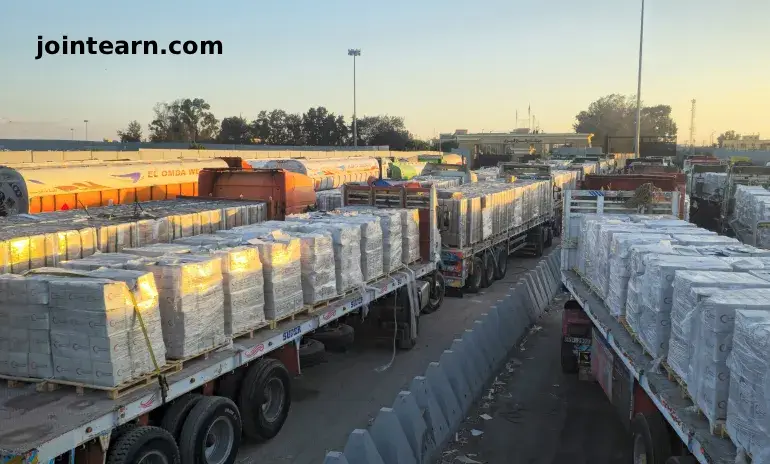
Gaza City – October 16, 2025:
Days after Israel and Hamas declared a ceasefire, Gaza’s hospitals remain on the brink of collapse, with thousands of sick and malnourished children still awaiting critical medical aid. Despite the truce, Israeli restrictions continue to choke the entry of humanitarian supplies, leaving Gaza’s most vulnerable — babies, mothers, and the elderly — fighting for survival.
Aid Blockade Persists Despite Ceasefire Agreement
According to humanitarian officials, fewer than 300 aid trucks are entering Gaza daily — only half the minimum required to meet the population’s basic needs. Even among these, many carry commercial goods rather than essential humanitarian supplies like food, medicine, or fuel.
Al Jazeera’s correspondent Hind Khoudary, reporting from Deir el-Balah, described the desperate conditions faced by civilians:
“Children don’t have anything — no clothes, no medical supplies, no food. What’s entering are commercial trucks for the markets, but people don’t even have money to buy those items. Banks haven’t reopened, and aid warehouses are still empty.”
The ongoing aid bottleneck has left hospitals and shelters unable to meet growing demands as Gaza’s health infrastructure continues to collapse after two years of devastating conflict.
Gaza’s Hospitals Running Out of Medicine and Fuel
At the Patient’s Friends Benevolent Society (PFBS) Hospital in Gaza City, doctors describe conditions as catastrophic. With dwindling medicine, food, and electricity, even basic healthcare is becoming impossible to provide.
“We are still waiting for the medical and humanitarian aid to reach our hospital,” said Dr. Musab Farwana, a pediatrician. “When it arrives, the situation will surely improve — especially for the children, who remain the most vulnerable to malnutrition.”
For many families, the wait is unbearable. Randa Aldhadar, the mother of baby Ruqayya, told Al Jazeera that her daughter’s life hangs in the balance.
“The hospital doesn’t have milk, biscuits, or nutritional supplements,” Randa said. “I can’t produce milk myself because of hunger. My baby is severely malnourished — she’s on the brink of death.”
Medical Collapse After Years of War
Gaza’s health system, already battered by Israeli airstrikes and years of siege, has reached its worst point yet.
Hundreds of medical facilities have been damaged or destroyed, and more than 600 healthcare workers have been killed since 2023, according to Palestinian health authorities.
The two-year blockade and constant bombardment have left hospitals without fuel for generators, forcing many intensive care units to shut down and leaving babies in incubators and critical care patients without life support.
Ceasefire Promises vs. Reality on the Ground
The ceasefire agreement reached last week between Hamas and Israel was meant to bring relief to Gaza’s 2.2 million residents. The deal included:
- The exchange of Israeli captives for approximately 2,000 Palestinian prisoners;
- The lifting of the humanitarian blockade to allow the flow of food, medicine, and water.
Yet, Israel’s enforcement of border controls has severely limited aid entry. As of Thursday, the Rafah crossing — Gaza’s vital southern gateway into Egypt — remains closed.
The Israeli Defense Ministry’s COGAT agency confirmed that no humanitarian supplies would pass through Rafah, claiming the crossing was not part of the agreement. Instead, aid is restricted to entry via Karem Abu Salem (Kerem Shalom), which humanitarian groups say cannot handle the necessary volume.
Families Trapped, Children in Crisis
At PFBS Hospital, Tahani Hassouna sits beside her daughter Alma, who suffers from a congenital heart condition.
“There’s not enough medical equipment or oxygen,” she said. “Alma can’t gain weight and needs constant oxygen just to breathe. Every day, I wait for the border to reopen so we can leave for surgery.”
Doctors estimate that over 12,000 children in Gaza require urgent medical treatment abroad, but none have been granted permission to travel since the blockade began in April.
No Sign of Relief in Gaza’s Health Crisis
At al-Shifa Hospital, Gaza’s largest medical complex, Dr. Mohammed Abu Salmiya, the medical director, said he has not seen “any notable improvement” since the ceasefire took effect.
“The health situation in Gaza remains tragic. We have no fuel, no medicine, and no access to humanitarian aid,” Salmiya told Al Jazeera. “It’s as if the ceasefire only exists on paper.”
Humanitarian groups, including the World Health Organization (WHO) and UNICEF, have urged Israel to fully lift restrictions, warning that Gaza’s healthcare system is “one collapse away from total failure.”
International Calls for Humanitarian Access
The United Nations, Red Cross, and several European governments have called for Israel to allow full and unconditional aid entry to Gaza. The UN Humanitarian Office (OCHA) reported that more than 70 percent of Gaza’s population is now dependent on external assistance.
Meanwhile, Egypt has said it is ready to facilitate the flow of aid through Rafah, pending Israel’s approval.
“We are ready on the Egyptian side,” a Cairo official told local media. “The issue is with Israeli clearance.”
Gaza’s Children: The Human Face of the Crisis
As the ceasefire enters its second week, the situation remains dire.
The lack of medical care, clean water, and food has pushed Gaza’s children to the brink.
Doctors describe cases of acute malnutrition, cholera, and respiratory failure rising sharply in recent days.
Without immediate humanitarian access, aid agencies warn that the death toll among children could rise significantly, even in the absence of active fighting.


Leave a Reply